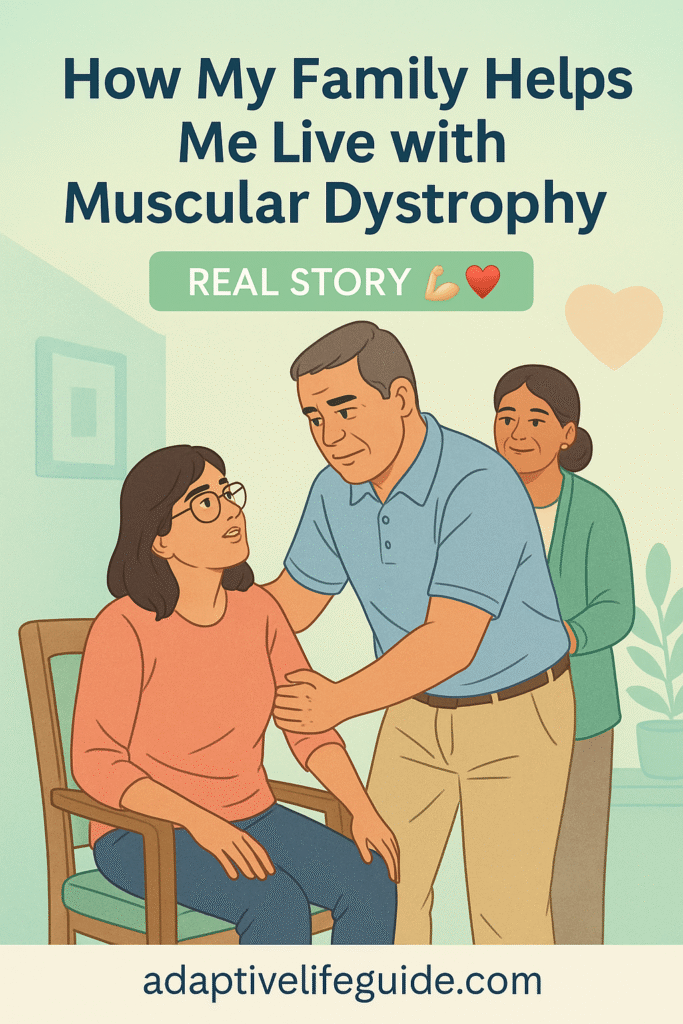
By Anshuli Singhal
Table of Contents
Introduction
Living with Muscular Dystrophy (MD) comes with unique physical challenges, but what has made my journey manageable—and even fulfilling—is the unwavering support of my family. I’m Anshuli Singhal, and I’ve lived with muscular dystrophy for over 15 years. While I may not use a wheelchair at home, I rely heavily on my loved ones for day-to-day activities that most people take for granted. This article is not just my story but a guide for families supporting someone with MD.
Daily Mobility Support at Home
One of the most crucial aspects of living with MD is mobility assistance, especially when getting in and out of bed. My family members have become my caregivers, gently helping me rise every morning. I can walk slowly indoors, but if I fall, I can’t get up on my own. It’s my family who lift me up, support me on my legs, and help me regain balance. Their help isn’t just physical—it’s emotional strength that pushes me forward.
Wheelchair Use: Only When Needed
Unlike many others, I don’t rely on a wheelchair inside the home. I move around slowly with caution, holding onto walls or furniture when needed. However, during outdoor travel or long distances, I use a wheelchair. This allows me to participate in family outings or doctor visits comfortably. My family ensures the wheelchair is always ready when we step out.
Bathroom Modifications: A Small Change, Big Relief
A standard bathroom can be incredibly difficult to use with muscular dystrophy. That’s why my family installed a commode setup tailored to my needs. These kinds of home modifications may seem minor, but they bring immense independence and dignity. Whether it’s grab bars, elevated toilet seats, or a more accessible layout, such adjustments make life significantly easier.
Avoiding Stairs: A Smart Home Adaptation
One of my greatest challenges is climbing stairs. It’s nearly impossible for me now, so my family made sure our home has no stairs at the entrance. This single decision has helped reduce the risk of falls and given me safer access to the house. If you’re designing or remodeling a home for someone with MD, a stair-free entry is a must-have feature.
Getting In and Out of Vehicles
Getting in or out of a car might look simple, but for me, it’s a task that requires careful support. My family helps me stand from the car seat and gently assists me in gaining balance before I walk. These are small acts of love, but they carry tremendous importance for someone with limited mobility. They ensure I can attend functions, family gatherings, or even just go out for a drive.
Two-Wheeler Seating: Small Freedoms Matter
One might think someone with muscular dystrophy would avoid two-wheelers completely—but not me. I can still sit comfortably on a two-wheeler with help of my family to lift my legs to keep on two wheeler foot pegs , which gives me a sense of freedom and normalcy. With someone driving and taking safety precautions, this small action becomes a big mental boost.
Emotional Strength Through Family Support
Beyond physical help, emotional support from family is my biggest pillar. Their constant presence gives me confidence to face the uncertainties of this condition. Whether it’s a comforting word, a hand to hold, or just sitting with me when I’m tired—every act of care builds my inner strength.
Final Thoughts
Family support in muscular dystrophy is not just about lifting, helping, or driving—it’s about sharing the burden of a disease that can be isolating without compassion. My journey has been smoother because my family walks beside me every step of the way. If you’re a caregiver or a loved one, know that your presence matters more than you realize.
FAQs
Q1. Can someone with muscular dystrophy live without a wheelchair?
Yes, some people like me don’t use a wheelchair at home and move around slowly. However, wheelchairs can be essential for long distances or travel.
Q2. What are essential home modifications for someone with MD?
Installing grab bars, a commode suited to the individual, and avoiding stairs at entry points are some helpful changes.
Q3. Is emotional support as important as physical help?
Absolutely. Emotional encouragement can greatly improve confidence, mood, and overall quality of life.
Q4. Can someone with MD sit on a two-wheeler?
Yes, depending on the severity of their condition. I personally can sit on a two-wheeler with some help if someone else drives it.
Q5. How can family help during a fall?
If a person falls and can’t get up on their own, family members should be trained on how to lift safely without causing injury.
If you found this article helpful, please share it to spread awareness. Together, we can build a more supportive world for people living with muscular dystrophy.
